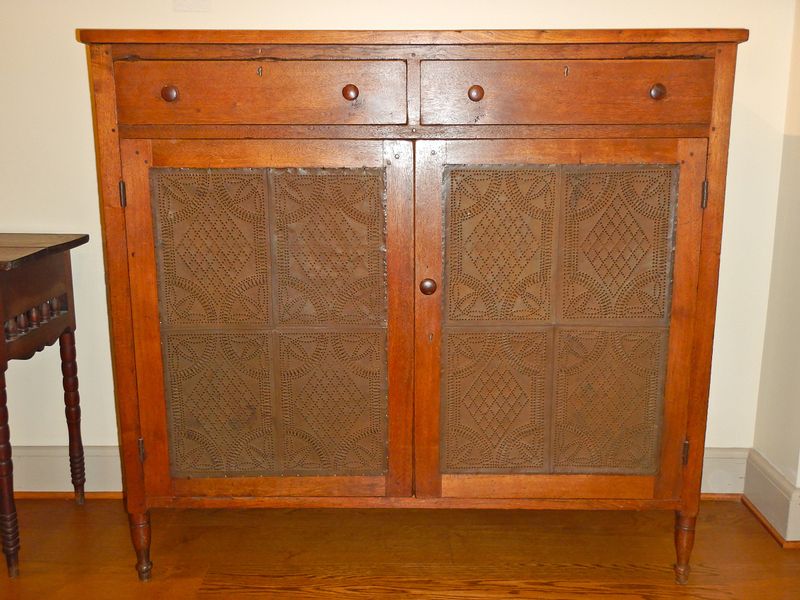A Sample of Tennessee Furniture
Last Updated 1/24/2025
By Jubilee P. Reid

Currently on display in Gallery One of the McMinn County Living Heritage Museum is a 16-piece collection of antique furniture. Most of this collection was hand-produced in Tennessee, with a few pieces originating in Kentucky and North Carolina. These examples of historic furniture are part of a private collection belonging to Mr. Johnny Cartwright of Cleveland, Tennessee who generously loaned them to the museum for the enjoyment of the community.
One of the prominent pieces of this collection is a pie safe from Grainger County, Tennessee. Pie safes are believed to have been introduced in the United States in the 1700s by German immigrants in Pennsylvania (known as Pennsylvania Dutch). These safes were generally tall standalone wooden cabinets with shelves made from locally sourced wood such as yellow pine. The doors on pie safes allowed ventilation. Early safes used cheesecloth while later ones included panels of tin or screen tacked onto the wood. Tin panels would have designs punched in them to allow airflow without letting flies in. A common practice to prevent pests from accessing the foods in pie safes was to place their feet in small dishes of coal oil to prevent ants from crawling up the legs. However, this stained the wooden feet and, combined with moisture damage, caused the lower portions of the legs of many pie safes to be sawed off in later years. Many pie safes were originally painted although the paint has long since worn off most antique samples.
The first mention of a pie safe in Tennessee was recorded in an 1804 Knox County estate inventory although these cabinets were in use in Tennessee years earlier. According to Derita Coleman Williams and Nathan Harsh, authors of The Art and Mystery of Tennessee Furniture and Its Makers Through 1850, pie safes are one of the most prevalent types of surviving furniture built in Tennessee prior to 1850. The pie safe exhibited at the museum is included in this comprehensive book.
This safe is made of walnut and tulip poplar, has two lockable drawers, and stands 48 inches tall, 50 inches wide, and 16 inches deep. It was produced around 1840-1850 in Grainger County by George W. Moyers (1813 – 1894) and a relative, David N. Sears (1810 – 1872). The 12 punched tin panels on the front and sides of this piece feature a decorative diamond pattern and are believed to have been made by Moyers’ brother-in-law, Fleming Kean Rich (1806 – 1861) of Wytheville, Virginia. Punched tin from Wytheville was both higher quality and less expensive than what was available in nearby Knoxville. Noticing the demand for these cabinets, Moyers requested 35 sets of tin from Rich in 1841. At this point Moyers already had 30 orders for pie safes.
Before the spread of iceboxes and the invention of refrigeration, pie safes were a common storage method for baked goods. The simple design of these cabinets hardly changed throughout the many years they were used. One can only imagine how many pies, breads, and other foods have been stored in the approximately 185-year-old piece on display.
Also in the museum’s exhibit are multiple sugar chests from Tennessee and Kentucky. (“Sugar chest” is a common term, interchangeable with a variety of other names encompassing multiple cabinet styles with similar purposes.) These small cases with locking lids on the top were popular in the late 1700s and 1800s when sugar was an expensive commodity. Sugar chests were usually kept in a formal dining room or parlor where they represented a status of wealth. There was often a divider inside these cabinets to separate light and dark sugar which at this time came in the form of cones. As sugar became more affordable over the years, other foods such as coffee, spices, and alcohol were often stored in the chests. One cannot appreciate the fine craftsmanship of these pieces without remembering their close entwinement with the sugar trade and enslavement of people.
Another piece in this collection, a large cherry/yellow pine blanket chest, believed to have been made in Cumberland County, Tennessee, has a particular connection to Athens. It belonged to Georgana Edgemon Kelsay (1926 – 2016) who grew up in Ten Mile and lived most of her life in Athens.
This temporary exhibit encompasses a variety of examples of Southern Appalachian wood furniture and will be on display at the museum until April 11th, 2025.

